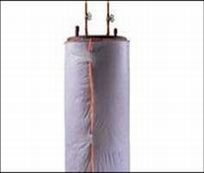- 128 reads

Spend $25 now and
SAVE $30 each year..
ROI = 120%
Highlights
Newer heaters have relatively high insulation, so to see if an Insulation Blanket is right for you, just put your hand on the outside of the heater. If it feels warm, then you can save money by wrapping it.
The water in the tank is heated up to 140 Degrees, and if it is in the basement or garage, the surrounding temperature in the winter is probably around 60 Degrees. This 80 Degree difference creates heat loss, and the blanket can save you 10% or more depending on the quality of your tank, accounting for savings of $8.35 over each month of the winter.
Water heating can account for roughly 19 percent of a home energy bill. The majority of U.S. houses have gas water heaters, but almost 40 percent use doubly expensive electric systems. Make your water heating 'system' more efficient by not only wrapping the tank with an insulating jacket, but also insulating hot water pipes, and consider installing timer controls that switch off the heater when you’re at work or sleeping. Turn the heater off when you’re on vacation. You can also add anti-convection valves and loops, and turn the temperature down from 140 to 120 degrees Fahrenheit or less.
The ROI Calculation is based on the 'Blanket' with other measures adding to the savings. The blankets typically range from $25 up to $80, and the more expensive ones typically have higher insulation values for even more savings.
Good to Know:
PLUS 1: Save Money by Lowering Water Heating Temperature - You can reduce your water heating costs by simply lowering the thermostat setting on your water heater. For each 10ºF reduction in water temperature, you can save between 3%–5% in energy costs. Although some manufacturers set water heater thermostats at 140ºF, most households usually only require them set at 120ºF. So, at an average household cost of $400 per year in water heating energy, you could save about $30 to $40 with a 20ºF adjustment.
To set the temperature, you can typically find a thermostat dial for a gas fired water heater near the bottom of the tank on the gas valve. Electric water heaters, on the other hand, may have thermostats positioned behind screw-on plates or panels. As a safety precaution, shut off the electricity to the water heater before removing/opening the panels. Keep in mind that an electric water heater may have two thermostats—one each for the upper and lower heating elements.
Reducing your water temperature to 120ºF also reduces the mineral buildup and corrosion in your water heater and pipes. So, your water heater last longer and operate at its maximum efficiency. If you plan to be away from home for a long weekend or vacation, turn the thermostat down to the lowest setting or completely turn off the water heater. To turn off an electric water heater, switch off the circuit breaker to it. For a gas water heater, make sure you know how to safely relight the pilot light before turning it off.
PLUS 2: Save even more money by insulating Hot Water Pipes - Insulating your hot water pipes reduces heat loss and can raise water temperature 2ºF–4ºF hotter than uninsulated pipes can deliver, allowing you to lower your water heater temperature and save money. You also won't have to wait as long for hot water when you turn on a faucet or shower head, which helps conserve water. For each 10ºF reduction in water temperature, you can save between 3%–5% in energy costs. At best each 1ºF reduction equals .5% savings on energy. So, if well insulated pipes let you reduce the temperature by 4ºF the savings is about 2% in energy each year. Insulate all accessible hot water pipes, especially within 3 feet of the water heater.
It's also a good idea to insulate the cold water inlet pipes for the first 3 feet. Use quality pipe insulation wrap, or neatly tape strips of fiberglass insulation around the pipes. Pipe sleeves made with polyethylene or neoprene foam are the most commonly used insulation. Match the pipe sleeve's inside diameter to the pipe's outside diameter for a snug fit. Place the pipe sleeve so the seam will be face down on the pipe. Tape, wire, or clamp (with a cable tie ) it every foot or two to secure it to the pipe. If you use tape, some recommend using acrylic tape instead of duct tape. On gas water heaters, keep insulation at least 6 inches from the flue. If pipes are within 8 inches of the flue, your safest choice is to use fiberglass pipe-wrap (at least 1-inch thick) without a facing. You can use either wire or aluminum foil tape to secure it to the pipe.
 Basically, if your tank is warm to the touch then you could benefit from adding a Hot Water Heater ‘Blanket’.
Basically, if your tank is warm to the touch then you could benefit from adding a Hot Water Heater ‘Blanket’.
TAKE ACTION
Great prices and selection. Search on 'Water Heater Blanket' as well as other great products to save on utility bills: Click Here
Find a Water Heating Installation Specialist near you (Pre-Screened and/or Member Referred): Click Here


